All Categories
Featured
In home design, door placement commonly takes a backseat to larger architectural decisions, yet it plays a pivotal role in shaping just how a house operates and really feels. Correct door placing makes certain that spaces are efficient, aesthetically pleasing, and for a comfortable way of living. Here's an in-depth take a look at the scientific research behind door placement and why it is worthy of more attention in the layout procedure.
Doors are the entrances that attach one space to an additional, and their positioning needs to promote smooth motion throughout the home.
Secret Factors To Consider:
Rational Pathways: Setting doors to line up with natural website traffic patterns. For example, a kitchen door ought to provide straight accessibility to the dining area to streamline everyday routines.
Reducing Obstacles: Prevent placing doors where furniture or structural components might block their swing or develop traffic jams.
Transitions: Use doorways to mark changes between public and private areas, such as corridors leading to bedrooms.
The positioning of doors can dramatically affect how light and air circulate within a home, contributing to its general setting and energy performance.
Placement Methods:
Cross-Ventilation: Area doors other openings or opposite home windows to advertise airflow, especially in warm environments.
Sunshine Optimization: Think about the orientation of outside doors to record early morning or mid-day light, lightening up insides naturally.
Glass Doors: Use doors with glass inserts to enable light to filter via, boosting brightness in surrounding rooms.
Critical door positioning is essential for maintaining personal privacy in key areas without endangering availability.
Ideal Practices:
Bedrooms and Bathrooms: Position these doors away from high-traffic areas like living areas or kitchen areas to create a feeling of hideaway.
Visitor Locations: For homes with visitor suites, doors must offer both simple access and personal privacy for visitors.
Key Entrance: The front door needs to offer straight access to usual locations without disclosing too much of the home's interior.
Beyond performance, doors play a significant function in the visual comprehensibility of a space. Their positioning and design must improve the home's visual allure.
Layout Tips:
Proportion and Equilibrium: Line up doors symmetrically in shared spaces like corridors to develop a sense of order.
Centerpieces: Use grand entrance doors or unique styles as visual highlights.
Uniformity: Match door designs and surfaces across the home for a natural appearance.
Door positioning can influence a home's power efficiency by regulating heat circulation and insulation.
![]()
Energy-Saving Techniques:
Protected Doors: Usage well-insulated exterior doors to lower energy loss.
Wind Security: Position primary doors away from dominating wind instructions or make use of vestibules to reduce drafts.
Zoning: Use doors to section off locations of the home for targeted home heating or cooling.
![]()
In lots of cultures, the positioning of doors lugs symbolic definition and can influence how a home is perceived.
Instances:
Feng Shui: In this tradition, the front door's positioning influences the circulation of "chi" or energy, with guidelines highlighting visibility and balance.
![]()
Directional Placement: In Vastu Shastra, an ancient Indian design approach, door alignment is thought to impact success and harmony.
Entrance Statements: Grand entryways or elaborately created doors can signify heat and hospitality.
Final Ideas
Door positioning is both a science and an art. When prepared properly, doors become a lot more than just entrance factors; they form the whole living experience.
- Enhancing Spatial Circulation
Doors are the entrances that attach one space to an additional, and their positioning needs to promote smooth motion throughout the home.
Secret Factors To Consider:
Rational Pathways: Setting doors to line up with natural website traffic patterns. For example, a kitchen door ought to provide straight accessibility to the dining area to streamline everyday routines.
Reducing Obstacles: Prevent placing doors where furniture or structural components might block their swing or develop traffic jams.
Transitions: Use doorways to mark changes between public and private areas, such as corridors leading to bedrooms.
- Taking Full Advantage Of Natural Light and Air Flow
The positioning of doors can dramatically affect how light and air circulate within a home, contributing to its general setting and energy performance.
Placement Methods:
Cross-Ventilation: Area doors other openings or opposite home windows to advertise airflow, especially in warm environments.
Sunshine Optimization: Think about the orientation of outside doors to record early morning or mid-day light, lightening up insides naturally.
Glass Doors: Use doors with glass inserts to enable light to filter via, boosting brightness in surrounding rooms.
- Balancing Privacy and Ease Of Access
Critical door positioning is essential for maintaining personal privacy in key areas without endangering availability.
Ideal Practices:
Bedrooms and Bathrooms: Position these doors away from high-traffic areas like living areas or kitchen areas to create a feeling of hideaway.
Visitor Locations: For homes with visitor suites, doors must offer both simple access and personal privacy for visitors.
Key Entrance: The front door needs to offer straight access to usual locations without disclosing too much of the home's interior.
- Aesthetic Combination
Beyond performance, doors play a significant function in the visual comprehensibility of a space. Their positioning and design must improve the home's visual allure.
Layout Tips:
Proportion and Equilibrium: Line up doors symmetrically in shared spaces like corridors to develop a sense of order.
Centerpieces: Use grand entrance doors or unique styles as visual highlights.
Uniformity: Match door designs and surfaces across the home for a natural appearance.
- Power Effectiveness Considerations
Door positioning can influence a home's power efficiency by regulating heat circulation and insulation.

Energy-Saving Techniques:
Protected Doors: Usage well-insulated exterior doors to lower energy loss.
Wind Security: Position primary doors away from dominating wind instructions or make use of vestibules to reduce drafts.
Zoning: Use doors to section off locations of the home for targeted home heating or cooling.

- Symbolic and cultural Impacts
In lots of cultures, the positioning of doors lugs symbolic definition and can influence how a home is perceived.
Instances:
Feng Shui: In this tradition, the front door's positioning influences the circulation of "chi" or energy, with guidelines highlighting visibility and balance.

Directional Placement: In Vastu Shastra, an ancient Indian design approach, door alignment is thought to impact success and harmony.
Entrance Statements: Grand entryways or elaborately created doors can signify heat and hospitality.
Final Ideas
Door positioning is both a science and an art. When prepared properly, doors become a lot more than just entrance factors; they form the whole living experience.
Latest Posts
Take Advantage of Special Auto Repair Deals in Chicago at Montclare Auto Repair
Published May 31, 25
1 min read
Check Out the Greatest Auto Repair Discounts in Montclare, Chicago
Published May 26, 25
1 min read
Find Out Why Chicago Drivers Select Montclare Auto Repair for Reliable Service and Huge Savings
Published May 25, 25
1 min read
More
Latest Posts
Take Advantage of Special Auto Repair Deals in Chicago at Montclare Auto Repair
Published May 31, 25
1 min read
Check Out the Greatest Auto Repair Discounts in Montclare, Chicago
Published May 26, 25
1 min read
Find Out Why Chicago Drivers Select Montclare Auto Repair for Reliable Service and Huge Savings
Published May 25, 25
1 min read